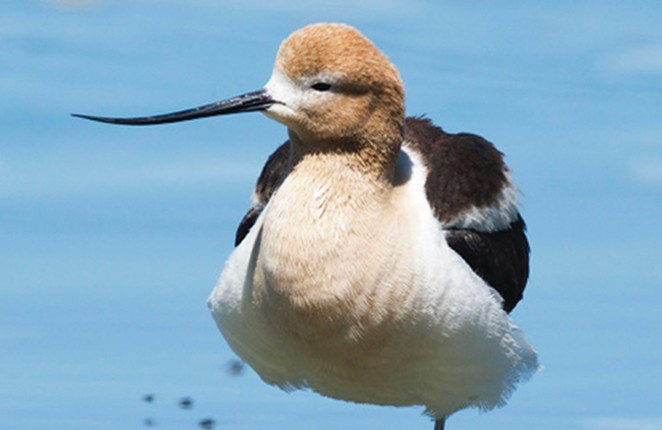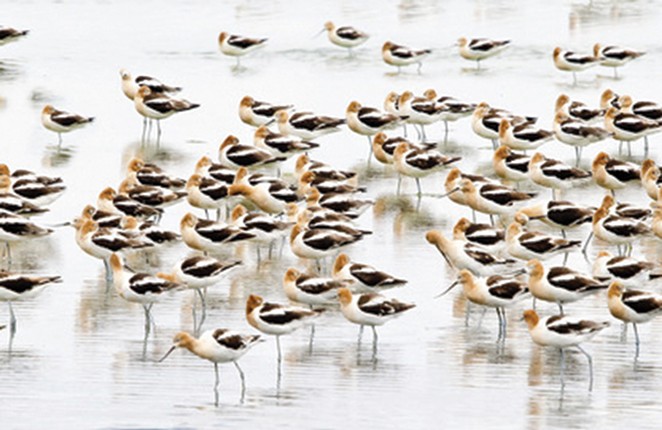Its large size and conspicuous colors could hardly be overlooked, even if it were shy and retiring," wrote renowned ornithologist Arthur C. Bent in "Life Histories of North American Shorebirds." The American avocet (Recurvirostra americana) is one of the most distinctive shorebirds in the Great Basin. Known as waders in the avocet and stilt family, they spend much of their time foraging in shallow water or on mud flats, sweeping their bills in water to seek prey. While it might sound like quite the life by the shore, populations of American avocet across the West have declined as a host of factors threaten the high desert oases they call home.
Habitat, Breeding and Migration
American avocet, a species that ranges throughout the central and western U.S., are one of the most common shorebirds in the northwestern Great Basin, an arid region between the Sierra Nevada and the Rocky Mountains that includes the eastern portion of Oregon. They frequent shallow fresh and saltwater habitats such as wetlands, saline lakes and ponds. In Oregon, you'll commonly see them in places like the Malheur National Wildlife Refuge, Summer Lake Wildlife Area, Goose Lake, the Klamath Basin, Warner Wetlands and Lake Abert.
Life for the avocet centers around breeding and migration. Wintering in southern California and Mexico, avocets migrate north in the spring to breed across the Great Basin. During breeding season, the species is easily identified by their long grey-blue legs and rust-colored head and neck, which are replaced by white feathers after molting. Males and females are nearly indistinguishable except for the curvature of their bill; males have a straighter bill while the females tend to curve upward. These differing beak structures provide unique advantages when foraging for food. With their straighter bill, males are more adept at probing the water column to feed. Females will sweep their bill from side to side — called scything — while wading to strain invertebrates from the water.
Although most avocets don't breed at Oregon's Lake Abert, in August and September birds flock to the lake to gorge on the abundant alkali fly and brine shrimp populations. As many as 40,000 avocets have been counted in a single day at Lake Abert, the highest abundance of anywhere in Oregon. Higher counts of avocets have only been recorded at the Great Salt Lake and Lahontan Wetlands, illustrating the importance of Lake Abert to avocet populations.
Lake Abert: A Hypersaline Oasis in Oregon's High Desert
Lake Abert is a remnant of ancient Lake Chewaucan, which once inundated 500 square miles in southeastern Oregon. Although only covering 64 square miles today, the lake is still one of the largest lakes in the state, measuring 15 miles long and up to 5 miles wide. Lake Abert has no outlet and millennia of evaporation has concentrated salt in the water, resulting in a hypersaline ecosystem that is saltier than the ocean. Brine shrimp and alkali flies have adapted to live in the highly salt-concentrated water, with each numbering in the billions, providing abundant food sources for avocets and other waterbirds that bulk up before migrating south for the winter.

Conservation Concerns
By most accounts, avocet populations are stable. However, the Great Basin lakes that avocets and other migratory birds depend on have been markedly shrinking in size due to the impacts from drought, climate change and water diversions. This is especially evident at Lake Abert, which went dry in 2014 for the first time since the Dust Bowl of the 1930s, when it shrank to just 5% of its maximum size. The lake was nearly dry again in 2015, 2016, 2021 and 2022. While avocets still showed up at Lake Abert during each drought year, only half as many were counted.
A collaborative coalition of stakeholders was recently convened to discuss potential solutions to the increasingly desiccated conditions at Lake Abert. The Saline Lakes Act, enacted by Congress late last year, dedicated funding for the U.S. Geological Survey to monitor saline lakes throughout the West, including Lake Abert — representing important and necessary progress toward saving this irreplaceable ecosystem.
Water levels throughout southeastern Oregon are higher this summer thanks to increased spring precipitation. If you have plans to travel through the high desert this summer and fall, make a trip to one of our many lakes and refuges to view the graceful, long-legged avocet.
—Anne White is the Wildlands Coordinator at Oregon Natural Desert Association, a nonprofit organization that protects and restores Oregon's high desert public lands and waters. Read more of her work at onda.org/author/anneonda-org/.
To learn more about the incredible value of Lake Abert visit onda.org/lake-abert.





















